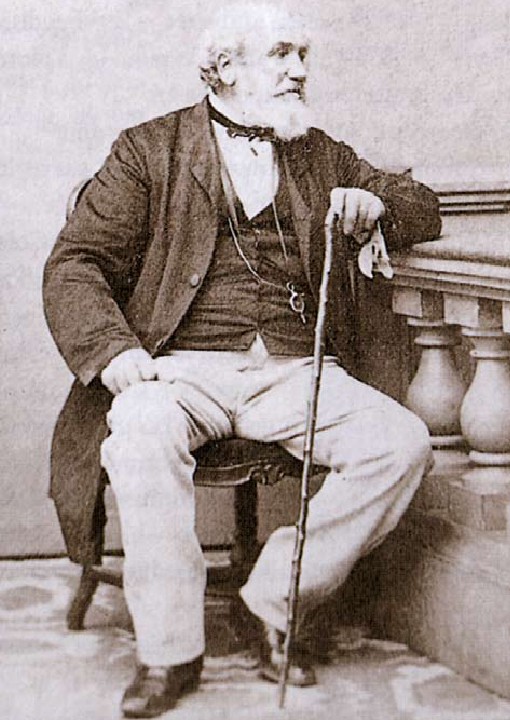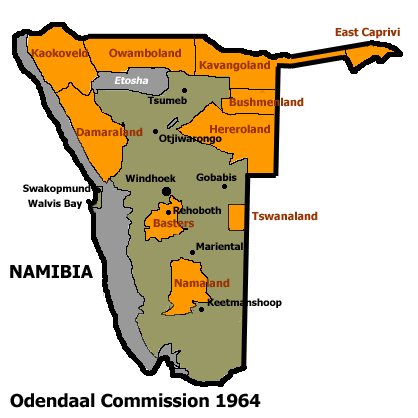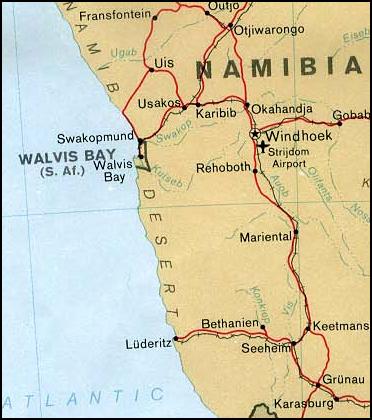|
Charles Davidson Bell
Charles Davidson Bell FRSE (22 October 1813 – 7 April 1882) was the Surveyor-General in the Cape Colony, an artist, heraldist, and designer of Cape medals and stamps. Life history Born on 22 October 1813 at Newhall, Crail, Fife, Scotland, he was educated locally at St Andrews University. Bell left Scotland and sailed to South Africa, landing at the Cape of Good Hope in 1830 and through his uncle Sir John Bell, Secretary to the Cape Government, was given a post in the civil service. He was appointed as expedition artist on Dr. Andrew Smith's two-year journey north as far as the Limpopo in 1834. He went from Acting Clerk of the Legislative Council in 1838, to Assistant Surveyor-General in 1843, to Surveyor-General in 1848. In 1851, he designed a silver gallantry medal for Cape governor Sir Harry Smith to present to troops during the 8th Frontier War. This is often referred to as the first South African medal. Appointed to the Postal Enquiry Board in 1852, he designed ... [...More Info...] [...Related Items...] OR: [Wikipedia] [Google] [Baidu] |
Charles Davidson Bell05
Charles is a masculine given name predominantly found in English and French speaking countries. It is from the French form ''Charles'' of the Proto-Germanic name (in runic alphabet) or ''*karilaz'' (in Latin alphabet), whose meaning was "free man". The Old English descendant of this word was '' Ċearl'' or ''Ċeorl'', as the name of King Cearl of Mercia, that disappeared after the Norman conquest of England. The name was notably borne by Charlemagne (Charles the Great), and was at the time Latinized as ''Karolus'' (as in ''Vita Karoli Magni''), later also as '' Carolus''. Some Germanic languages, for example Dutch and German, have retained the word in two separate senses. In the particular case of Dutch, ''Karel'' refers to the given name, whereas the noun ''kerel'' means "a bloke, fellow, man". Etymology The name's etymology is a Common Germanic noun ''*karilaz'' meaning "free man", which survives in English as churl (< Old English ''ċeorl''), which developed its ... [...More Info...] [...Related Items...] OR: [Wikipedia] [Google] [Baidu] |
Heraldry
Heraldry is a discipline relating to the design, display and study of armorial bearings (known as armory), as well as related disciplines, such as vexillology, together with the study of ceremony, rank and pedigree. Armory, the best-known branch of heraldry, concerns the design and transmission of the heraldic achievement. The achievement, or armorial bearings usually includes a coat of arms on a shield, helmet and crest, together with any accompanying devices, such as supporters, badges, heraldic banners and mottoes. Although the use of various devices to signify individuals and groups goes back to antiquity, both the form and use of such devices varied widely, as the concept of regular, hereditary designs, constituting the distinguishing feature of heraldry, did not develop until the High Middle Ages. It is often claimed that the use of helmets with face guards during this period made it difficult to recognize one's commanders in the field when large armies gathered toge ... [...More Info...] [...Related Items...] OR: [Wikipedia] [Google] [Baidu] |
Andrew Geddes Bain
Andrew Geddes Bain (baptised 11 June 1797 – 20 October 1864), was a South African geologist, road engineer, palaeontologist and explorer. Life history The only child of Alexander Bain and Jean Geddes, both of whom died when Bain was still a young boy, Bain was baptised 11 June 1797 in Thurso, Scotland. He was raised by an aunt who lived near Edinburgh. Here he received a classical education, but no vocational training. In 1816 he emigrated to Cape Town accompanied by his uncle Lieutenant Colonel William Geddes of the 83rd Regiment, who was stationed in the Cape. He married Maria Elizabeth von Backstrom on 16 November 1818 and had 3 sons and 7 daughters. In 1822 he bought property in Graaff Reinet and carried on for some years the business of a saddler. In 1825 he accompanied John Burner Biddulph on a trading expedition to Kuruman, the mission outpost on the edge of the Kalahari and home of Dr. Robert Moffat (father-in-law of David Livingstone). They explored further north a ... [...More Info...] [...Related Items...] OR: [Wikipedia] [Google] [Baidu] |
Hopetown
Hopetown is a town which lies at the edge of the Great Karoo in South Africa's Northern Cape province. It is situated on an arid slope leading down to the Orange River. The first diamond discovered in South Africa, the Eureka Diamond, was found at Hopetown. History Hopetown was founded in 1850 when Sir Harry Smith extended the northern frontier of the Cape Colony to the Orange River. A handful of settlers claimed ground where there was a natural ford over the Orange River, and by 1854 a frontier town had developed. Hopetown was named after William Hope, Auditor-General and Secretary of the Cape Colony Government at the time, and is often mistaken for a town in the Free State, South Africa, called Hoopstad. Hopetown was a quiet farming area until several large diamonds, most notable the Eureka Diamond and the Star of South Africa, were discovered there between 1867 and 1869. The Cape Government Railways were founded in 1872, and the Cape government decided to run the mai ... [...More Info...] [...Related Items...] OR: [Wikipedia] [Google] [Baidu] |
Kuruman
Kuruman is a small town with just over 53,000 inhabitants in the Northern Cape province of South Africa. It is known for its scenic beauty and the Eye of Kuruman, a geological feature that brings water from deep underground. The abundance of water produces an unexpected swathe of green amidst the barren plains and is known as the Oasis of the Kalahari. It was at first a mission station of the London Missionary Society founded by Robert Moffat in 1821. It was also the place where David Livingstone arrived for his first position as a missionary in 1841. The Kuruman River, which is dry except for flash floods after heavy rain, is named after the town. Origins Kuruman is regarded as the “Oasis of the Kalahari”. It is set out on the Ghaap Plateau and receives its water source from a spring called “The Eye” which rises in a cave in the semidesert thornveld area in the Kalahari region. Kuruman is the main town in the area and the spring gives about 20 to 30 million litres of wat ... [...More Info...] [...Related Items...] OR: [Wikipedia] [Google] [Baidu] |
Shoshong
Shoshong is a town in Botswana, formerly the chief settlement of the eastern Bamangwato. Physical location Shoshong is located just north of the Tropic of Capricorn at , in the Central District of Botswana, about west of Mahalapye. The town is situated above sea level in the valley of the Shoshong, an intermittent tributary of the Limpopo. Nearby villages are Tobela, Ikongwe, Kalamare, Mmutlane, and Mosolotshane. Shoshong is encircled by hills used for grazing cattle, and is a windy place. The central kgotla is located by the mouth of the steep valley (kloof) which used to be the source of water for the village. History Shoshong was initially inhabited by BaPhaleng, who were later joined by Bakaa, and later BaNgwato under King Sekgoma I. Oral traditions from the village points that the Baphaleng chief invited Bangwato from Mosu where they were continuously harassed and vulnerable to Matebele attacks. The site of Shoshong was chosen as being easily defensible against t ... [...More Info...] [...Related Items...] OR: [Wikipedia] [Google] [Baidu] |
Lake Ngami
Lake Ngami is an endorheic lake in Botswana north of the Kalahari Desert. It is seasonally filled by the Taughe River, an effluent of the Okavango River system flowing out of the western side of the Okavango Delta. It is one of the fragmented remnants of the ancient Lake Makgadikgadi. Although the lake has shrunk dramatically beginning from 1890, it remains an important habitat for birds and wildlife, especially in flood year Lake Ngami had many famous visitors during the 19th (and into the 20th) century. In 1849 David Livingstone described it as a "shimmering lake, some long and 20 0 kmwide". Livingstone also made a few cultural notes about the people living in this area; he noticed they had a story similar to that of the Tower of Babel, except that the builders' heads were "cracked by the fall of the scaffolding" (''Missionary Travels'', chap. 26). One of the illustrations is known to have been made on the basis of a sketch by Mr. Alfred Ryder (1825-1850) son of Artist, ... [...More Info...] [...Related Items...] OR: [Wikipedia] [Google] [Baidu] |
Hereroland
Hereroland was the first bantustan in South West Africa (present day Namibia), intended by the apartheid government to be a self-governing homeland for the Herero people The Herero ( hz, Ovaherero) are a Bantu ethnic group inhabiting parts of Southern Africa. There were an estimated 250,000 Herero people in Namibia in 2013. They speak Otjiherero, a Bantu language. Though the Herero primarily reside in Namibia, t .... It was set up in 1968. Hereroland, like other homelands in South West Africa, was abolished in May 1989 at the start of the transition to independence. See also * Apartheid * Leaders of Hereroland References History of Namibia Bantustans in South West Africa Herero people States and territories established in 1968 States and territories disestablished in 1989 1968 establishments in South West Africa {{Namibia-hist-stub ... [...More Info...] [...Related Items...] OR: [Wikipedia] [Google] [Baidu] |
Walvis Bay
Walvis Bay ( en, lit. Whale Bay; af, Walvisbaai; ger, Walfischbucht or Walfischbai) is a city in Namibia and the name of the bay on which it lies. It is the second largest city in Namibia and the largest coastal city in the country. The city covers a total area of of land. The bay is a safe haven for sea vessels because of its natural deepwater harbour, protected by the Pelican Point sand spit, being the only natural harbour of any size along the country's coast. Being rich in plankton and marine life, these waters also drew large numbers of southern right whales, attracting whalers and fishing vessels. A succession of colonists developed the location and resources of this strategic harbour settlement. The harbour's value in relation to the sea route around the Cape of Good Hope had caught the attention of world powers since it was discovered by the outside world in 1485. This explains the complicated political status of Walvis Bay down the years. The town is situat ... [...More Info...] [...Related Items...] OR: [Wikipedia] [Google] [Baidu] |
Bellville, Western Cape
Bellville is a town in the Western Cape province of South Africa. It is situated adjacent to the Koelberg Mountains and also the University of Western Cape where it has its own campus. Established It was founded as "12 Mile Post" (Afrikaans: "12-Myl-Pos") because it is located 12 miles (20 km) from Cape Town city centre. It was first known as "Hardekraaltjie". Founded as a railway station on the line from Cape Town to Stellenbosch and Strand, it was renamed Bellville in 1861 after the surveyor-general Charles Bell. The motor registration number bears the number CY. Hospitals and educational institutes The Karl Bremer Hospital functioned as the Academic Hospital for the University of Stellenbosch Medical School, but now the adjacent Tygerberg Hospital houses the medical school. Other hospitals in Bellville are: Mediclinic International Louis Leipoldt and Melomed. The Cape Peninsula University of Technology, University of the Western Cape, University of Ste ... [...More Info...] [...Related Items...] OR: [Wikipedia] [Google] [Baidu] |
James Chapman (explorer)
James Chapman (27 December 1831, Cape Town – 4 February 1872, Kimberley), was an explorer, hunter, trader and photographer from the Cape Colony. A son of James Chapman and Elizabeth Greeff of Malmesbury and brother to Henry Samuel Chapman, he was educated in Cape Town and left for Durban when 14 years old. He was appointed as chief clerk in the Native Affairs Department in 1848. A year later he settled in Potchefstroom where he became one of the first storekeepers. Shortly after, in 1852, he ventured across the Limpopo River and into Bamangwato country. He became friendly with Khama, one of the sons of Sekgoma, the Bamangwato chief, enlisting his aid in reaching the Chobe River. Early the following year found him on the Zambesi River which he explored to within of the Victoria Falls, almost beating David Livingstone to their discovery. By 1854 he had teamed up with Samuel H. Edwards, another explorer, and launched an expedition to Lake Ngami after which he trekked through the ... [...More Info...] [...Related Items...] OR: [Wikipedia] [Google] [Baidu] |
Africana Museum
Museum Africa or MuseuMAfricA (formerly known as the Africana Museum) is an historical museum in Newtown, Johannesburg, South Africa. History The museum was established in 1933, when the Johannesburg Public Library bought a large quantity of Africana material and books from John Gaspard Gubbins. From the mid-1930s, the museum's scope widened to include all aspects of African cultural history and material culture. The museum regularly published catalogues of the Africana it had in its collections, with titles such as "Military medals of South African interest", "Artists' impressions of Johannesburg, 1886-1956" and "Claudius water-colours in the Africana Museum". From 1943 to 1993 the museum also published the quarterly journal ''Africana Notes and News''. The museum established the following branch museums: James Hall Museum of Transport, 1964; Bensusan Photographic Museum and Library, 1969; The Museum of South African Rock Art, 1969; and the Bernberg Museum of Costume, 197 ... [...More Info...] [...Related Items...] OR: [Wikipedia] [Google] [Baidu] |





